Ethical Practice, Approaches, and Child Protection in Human Services
VerifiedAdded on 2023/06/11
|6
|1999
|105
Essay
AI Summary
This essay provides an overview of the code of ethics in human services, emphasizing its significance in ensuring quality treatment and respect for individuals. It discusses the functions and roles of the code of ethics, including guidance, support, discipline, education, and commitments to public image. The essay explores various fields of practice linked to social development work, such as aging, child welfare, education social work, public health, homelessness, and women's services. It also examines practical approaches like system theory and social learning theory, highlighting their applications in real-world settings. Furthermore, the essay addresses current issues in child protection, specifically child abuse and child labor, discussing their impact on children's well-being. Finally, it delves into potential ethical issues faced by human service practitioners, such as receiving gifts and involuntary commitment, and suggests ethical principles to address these challenges, referencing relevant literature and codes of conduct.
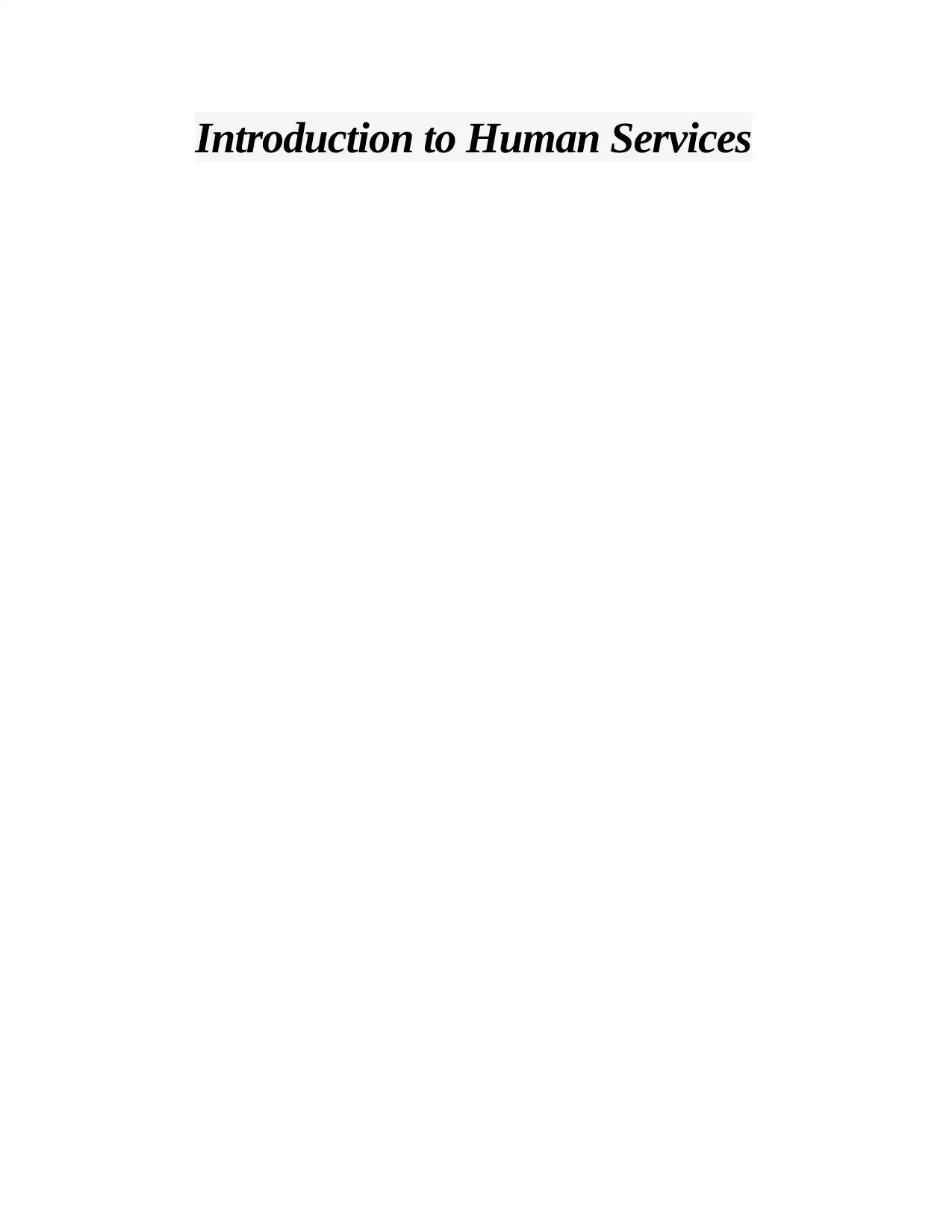
Introduction to Human Services
Paraphrase This Document
Need a fresh take? Get an instant paraphrase of this document with our AI Paraphraser
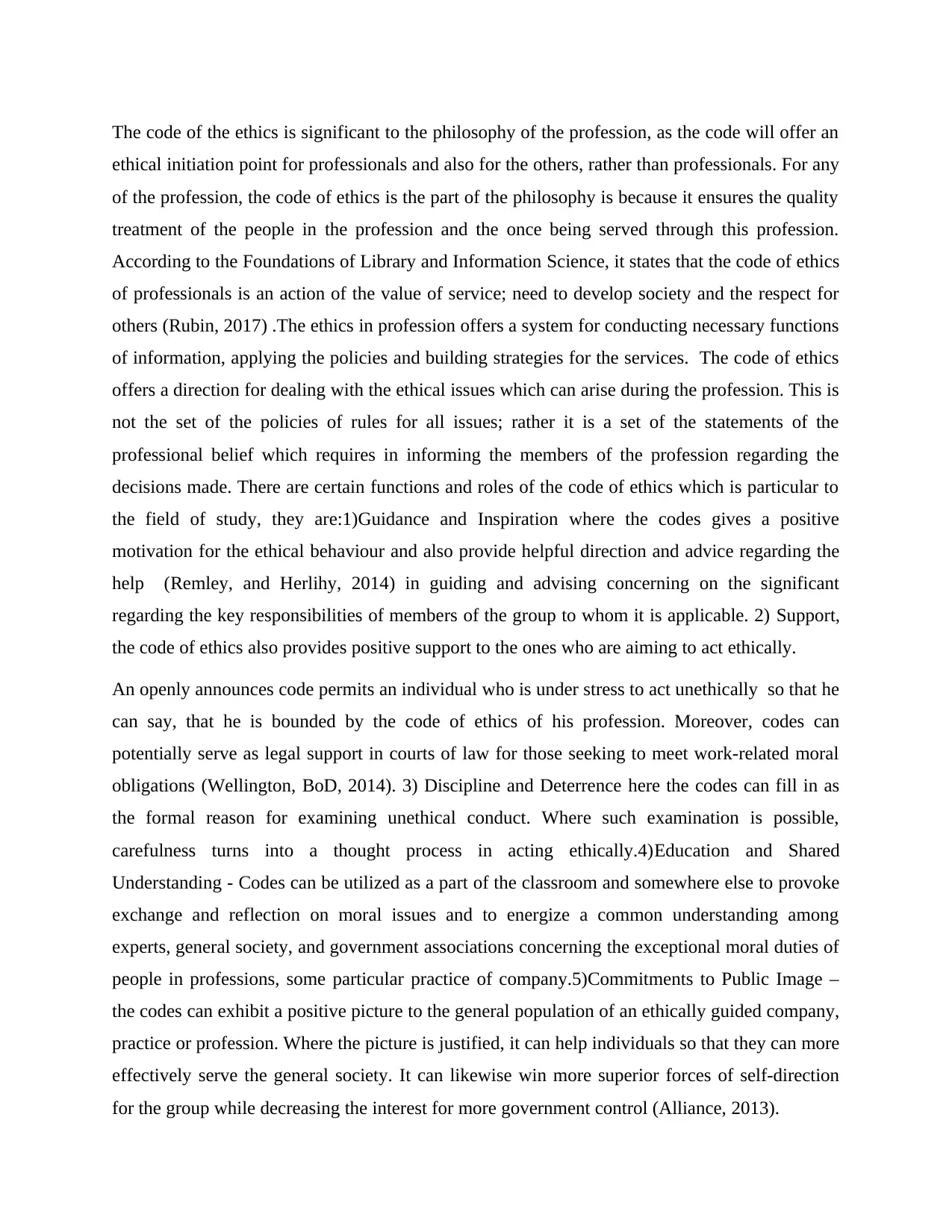
The code of the ethics is significant to the philosophy of the profession, as the code will offer an
ethical initiation point for professionals and also for the others, rather than professionals. For any
of the profession, the code of ethics is the part of the philosophy is because it ensures the quality
treatment of the people in the profession and the once being served through this profession.
According to the Foundations of Library and Information Science, it states that the code of ethics
of professionals is an action of the value of service; need to develop society and the respect for
others (Rubin, 2017) .The ethics in profession offers a system for conducting necessary functions
of information, applying the policies and building strategies for the services. The code of ethics
offers a direction for dealing with the ethical issues which can arise during the profession. This is
not the set of the policies of rules for all issues; rather it is a set of the statements of the
professional belief which requires in informing the members of the profession regarding the
decisions made. There are certain functions and roles of the code of ethics which is particular to
the field of study, they are:1)Guidance and Inspiration where the codes gives a positive
motivation for the ethical behaviour and also provide helpful direction and advice regarding the
help (Remley, and Herlihy, 2014) in guiding and advising concerning on the significant
regarding the key responsibilities of members of the group to whom it is applicable. 2) Support,
the code of ethics also provides positive support to the ones who are aiming to act ethically.
An openly announces code permits an individual who is under stress to act unethically so that he
can say, that he is bounded by the code of ethics of his profession. Moreover, codes can
potentially serve as legal support in courts of law for those seeking to meet work-related moral
obligations (Wellington, BoD, 2014). 3) Discipline and Deterrence here the codes can fill in as
the formal reason for examining unethical conduct. Where such examination is possible,
carefulness turns into a thought process in acting ethically.4)Education and Shared
Understanding - Codes can be utilized as a part of the classroom and somewhere else to provoke
exchange and reflection on moral issues and to energize a common understanding among
experts, general society, and government associations concerning the exceptional moral duties of
people in professions, some particular practice of company.5)Commitments to Public Image –
the codes can exhibit a positive picture to the general population of an ethically guided company,
practice or profession. Where the picture is justified, it can help individuals so that they can more
effectively serve the general society. It can likewise win more superior forces of self-direction
for the group while decreasing the interest for more government control (Alliance, 2013).
ethical initiation point for professionals and also for the others, rather than professionals. For any
of the profession, the code of ethics is the part of the philosophy is because it ensures the quality
treatment of the people in the profession and the once being served through this profession.
According to the Foundations of Library and Information Science, it states that the code of ethics
of professionals is an action of the value of service; need to develop society and the respect for
others (Rubin, 2017) .The ethics in profession offers a system for conducting necessary functions
of information, applying the policies and building strategies for the services. The code of ethics
offers a direction for dealing with the ethical issues which can arise during the profession. This is
not the set of the policies of rules for all issues; rather it is a set of the statements of the
professional belief which requires in informing the members of the profession regarding the
decisions made. There are certain functions and roles of the code of ethics which is particular to
the field of study, they are:1)Guidance and Inspiration where the codes gives a positive
motivation for the ethical behaviour and also provide helpful direction and advice regarding the
help (Remley, and Herlihy, 2014) in guiding and advising concerning on the significant
regarding the key responsibilities of members of the group to whom it is applicable. 2) Support,
the code of ethics also provides positive support to the ones who are aiming to act ethically.
An openly announces code permits an individual who is under stress to act unethically so that he
can say, that he is bounded by the code of ethics of his profession. Moreover, codes can
potentially serve as legal support in courts of law for those seeking to meet work-related moral
obligations (Wellington, BoD, 2014). 3) Discipline and Deterrence here the codes can fill in as
the formal reason for examining unethical conduct. Where such examination is possible,
carefulness turns into a thought process in acting ethically.4)Education and Shared
Understanding - Codes can be utilized as a part of the classroom and somewhere else to provoke
exchange and reflection on moral issues and to energize a common understanding among
experts, general society, and government associations concerning the exceptional moral duties of
people in professions, some particular practice of company.5)Commitments to Public Image –
the codes can exhibit a positive picture to the general population of an ethically guided company,
practice or profession. Where the picture is justified, it can help individuals so that they can more
effectively serve the general society. It can likewise win more superior forces of self-direction
for the group while decreasing the interest for more government control (Alliance, 2013).
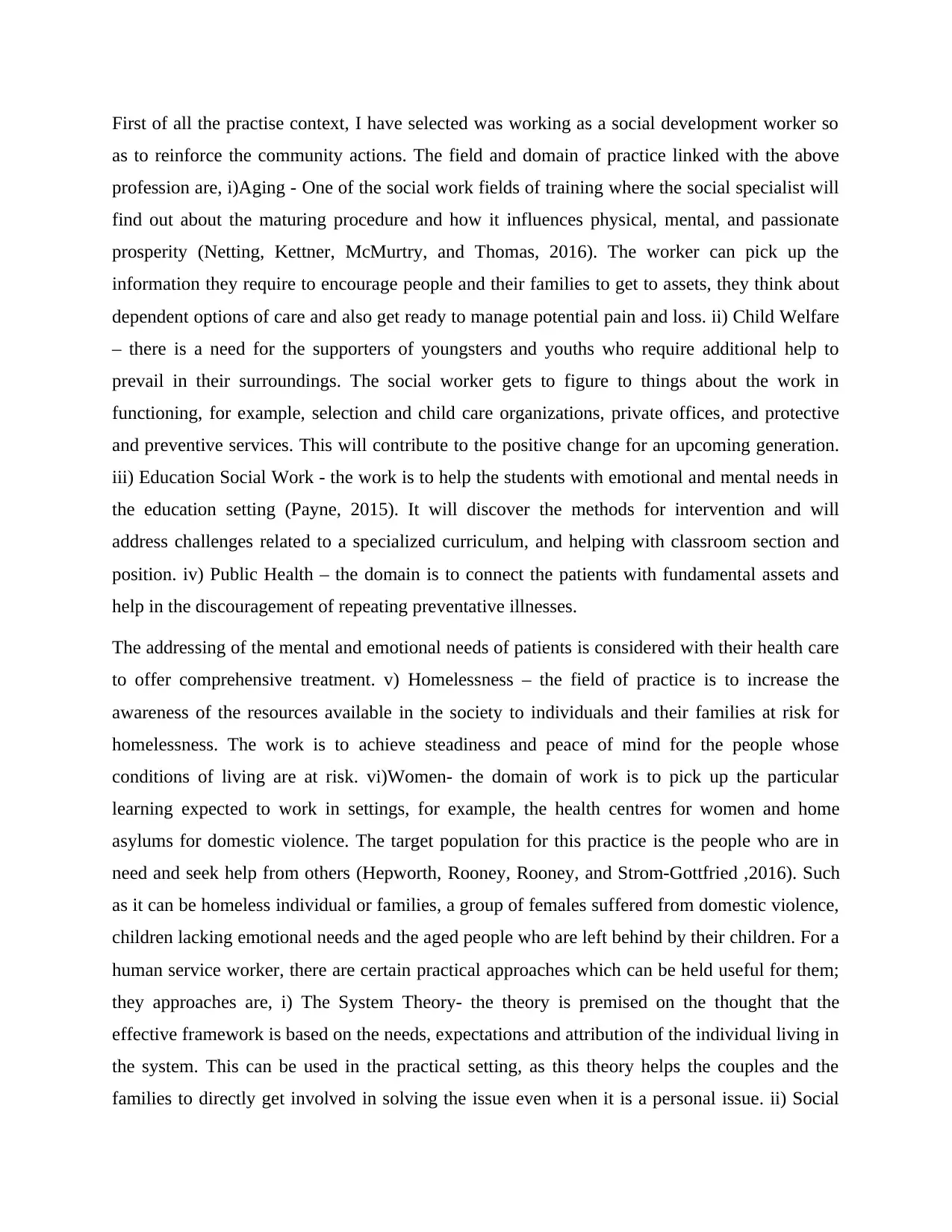
First of all the practise context, I have selected was working as a social development worker so
as to reinforce the community actions. The field and domain of practice linked with the above
profession are, i)Aging - One of the social work fields of training where the social specialist will
find out about the maturing procedure and how it influences physical, mental, and passionate
prosperity (Netting, Kettner, McMurtry, and Thomas, 2016). The worker can pick up the
information they require to encourage people and their families to get to assets, they think about
dependent options of care and also get ready to manage potential pain and loss. ii) Child Welfare
– there is a need for the supporters of youngsters and youths who require additional help to
prevail in their surroundings. The social worker gets to figure to things about the work in
functioning, for example, selection and child care organizations, private offices, and protective
and preventive services. This will contribute to the positive change for an upcoming generation.
iii) Education Social Work - the work is to help the students with emotional and mental needs in
the education setting (Payne, 2015). It will discover the methods for intervention and will
address challenges related to a specialized curriculum, and helping with classroom section and
position. iv) Public Health – the domain is to connect the patients with fundamental assets and
help in the discouragement of repeating preventative illnesses.
The addressing of the mental and emotional needs of patients is considered with their health care
to offer comprehensive treatment. v) Homelessness – the field of practice is to increase the
awareness of the resources available in the society to individuals and their families at risk for
homelessness. The work is to achieve steadiness and peace of mind for the people whose
conditions of living are at risk. vi)Women- the domain of work is to pick up the particular
learning expected to work in settings, for example, the health centres for women and home
asylums for domestic violence. The target population for this practice is the people who are in
need and seek help from others (Hepworth, Rooney, Rooney, and Strom-Gottfried ,2016). Such
as it can be homeless individual or families, a group of females suffered from domestic violence,
children lacking emotional needs and the aged people who are left behind by their children. For a
human service worker, there are certain practical approaches which can be held useful for them;
they approaches are, i) The System Theory- the theory is premised on the thought that the
effective framework is based on the needs, expectations and attribution of the individual living in
the system. This can be used in the practical setting, as this theory helps the couples and the
families to directly get involved in solving the issue even when it is a personal issue. ii) Social
as to reinforce the community actions. The field and domain of practice linked with the above
profession are, i)Aging - One of the social work fields of training where the social specialist will
find out about the maturing procedure and how it influences physical, mental, and passionate
prosperity (Netting, Kettner, McMurtry, and Thomas, 2016). The worker can pick up the
information they require to encourage people and their families to get to assets, they think about
dependent options of care and also get ready to manage potential pain and loss. ii) Child Welfare
– there is a need for the supporters of youngsters and youths who require additional help to
prevail in their surroundings. The social worker gets to figure to things about the work in
functioning, for example, selection and child care organizations, private offices, and protective
and preventive services. This will contribute to the positive change for an upcoming generation.
iii) Education Social Work - the work is to help the students with emotional and mental needs in
the education setting (Payne, 2015). It will discover the methods for intervention and will
address challenges related to a specialized curriculum, and helping with classroom section and
position. iv) Public Health – the domain is to connect the patients with fundamental assets and
help in the discouragement of repeating preventative illnesses.
The addressing of the mental and emotional needs of patients is considered with their health care
to offer comprehensive treatment. v) Homelessness – the field of practice is to increase the
awareness of the resources available in the society to individuals and their families at risk for
homelessness. The work is to achieve steadiness and peace of mind for the people whose
conditions of living are at risk. vi)Women- the domain of work is to pick up the particular
learning expected to work in settings, for example, the health centres for women and home
asylums for domestic violence. The target population for this practice is the people who are in
need and seek help from others (Hepworth, Rooney, Rooney, and Strom-Gottfried ,2016). Such
as it can be homeless individual or families, a group of females suffered from domestic violence,
children lacking emotional needs and the aged people who are left behind by their children. For a
human service worker, there are certain practical approaches which can be held useful for them;
they approaches are, i) The System Theory- the theory is premised on the thought that the
effective framework is based on the needs, expectations and attribution of the individual living in
the system. This can be used in the practical setting, as this theory helps the couples and the
families to directly get involved in solving the issue even when it is a personal issue. ii) Social
⊘ This is a preview!⊘
Do you want full access?
Subscribe today to unlock all pages.

Trusted by 1+ million students worldwide
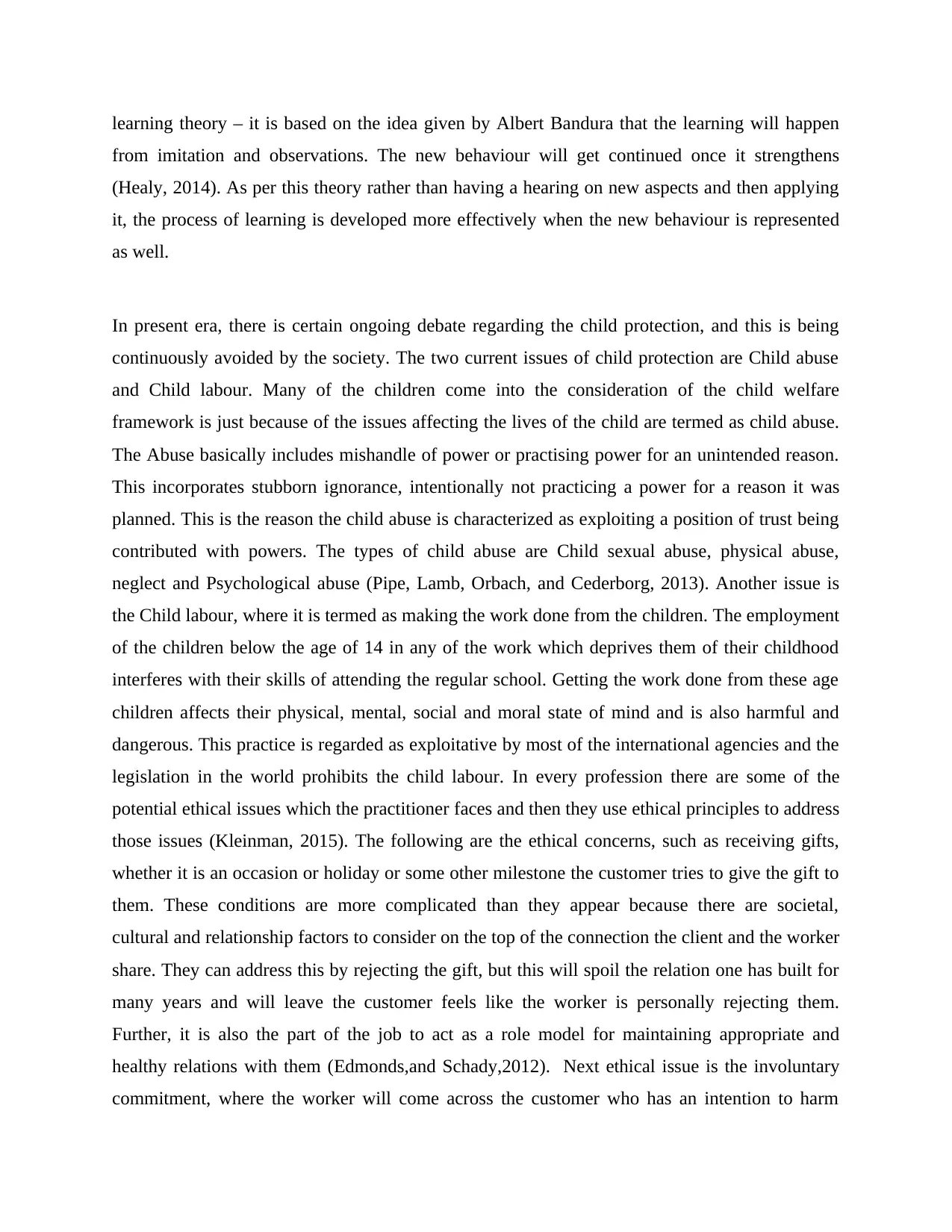
learning theory – it is based on the idea given by Albert Bandura that the learning will happen
from imitation and observations. The new behaviour will get continued once it strengthens
(Healy, 2014). As per this theory rather than having a hearing on new aspects and then applying
it, the process of learning is developed more effectively when the new behaviour is represented
as well.
In present era, there is certain ongoing debate regarding the child protection, and this is being
continuously avoided by the society. The two current issues of child protection are Child abuse
and Child labour. Many of the children come into the consideration of the child welfare
framework is just because of the issues affecting the lives of the child are termed as child abuse.
The Abuse basically includes mishandle of power or practising power for an unintended reason.
This incorporates stubborn ignorance, intentionally not practicing a power for a reason it was
planned. This is the reason the child abuse is characterized as exploiting a position of trust being
contributed with powers. The types of child abuse are Child sexual abuse, physical abuse,
neglect and Psychological abuse (Pipe, Lamb, Orbach, and Cederborg, 2013). Another issue is
the Child labour, where it is termed as making the work done from the children. The employment
of the children below the age of 14 in any of the work which deprives them of their childhood
interferes with their skills of attending the regular school. Getting the work done from these age
children affects their physical, mental, social and moral state of mind and is also harmful and
dangerous. This practice is regarded as exploitative by most of the international agencies and the
legislation in the world prohibits the child labour. In every profession there are some of the
potential ethical issues which the practitioner faces and then they use ethical principles to address
those issues (Kleinman, 2015). The following are the ethical concerns, such as receiving gifts,
whether it is an occasion or holiday or some other milestone the customer tries to give the gift to
them. These conditions are more complicated than they appear because there are societal,
cultural and relationship factors to consider on the top of the connection the client and the worker
share. They can address this by rejecting the gift, but this will spoil the relation one has built for
many years and will leave the customer feels like the worker is personally rejecting them.
Further, it is also the part of the job to act as a role model for maintaining appropriate and
healthy relations with them (Edmonds,and Schady,2012). Next ethical issue is the involuntary
commitment, where the worker will come across the customer who has an intention to harm
from imitation and observations. The new behaviour will get continued once it strengthens
(Healy, 2014). As per this theory rather than having a hearing on new aspects and then applying
it, the process of learning is developed more effectively when the new behaviour is represented
as well.
In present era, there is certain ongoing debate regarding the child protection, and this is being
continuously avoided by the society. The two current issues of child protection are Child abuse
and Child labour. Many of the children come into the consideration of the child welfare
framework is just because of the issues affecting the lives of the child are termed as child abuse.
The Abuse basically includes mishandle of power or practising power for an unintended reason.
This incorporates stubborn ignorance, intentionally not practicing a power for a reason it was
planned. This is the reason the child abuse is characterized as exploiting a position of trust being
contributed with powers. The types of child abuse are Child sexual abuse, physical abuse,
neglect and Psychological abuse (Pipe, Lamb, Orbach, and Cederborg, 2013). Another issue is
the Child labour, where it is termed as making the work done from the children. The employment
of the children below the age of 14 in any of the work which deprives them of their childhood
interferes with their skills of attending the regular school. Getting the work done from these age
children affects their physical, mental, social and moral state of mind and is also harmful and
dangerous. This practice is regarded as exploitative by most of the international agencies and the
legislation in the world prohibits the child labour. In every profession there are some of the
potential ethical issues which the practitioner faces and then they use ethical principles to address
those issues (Kleinman, 2015). The following are the ethical concerns, such as receiving gifts,
whether it is an occasion or holiday or some other milestone the customer tries to give the gift to
them. These conditions are more complicated than they appear because there are societal,
cultural and relationship factors to consider on the top of the connection the client and the worker
share. They can address this by rejecting the gift, but this will spoil the relation one has built for
many years and will leave the customer feels like the worker is personally rejecting them.
Further, it is also the part of the job to act as a role model for maintaining appropriate and
healthy relations with them (Edmonds,and Schady,2012). Next ethical issue is the involuntary
commitment, where the worker will come across the customer who has an intention to harm
Paraphrase This Document
Need a fresh take? Get an instant paraphrase of this document with our AI Paraphraser
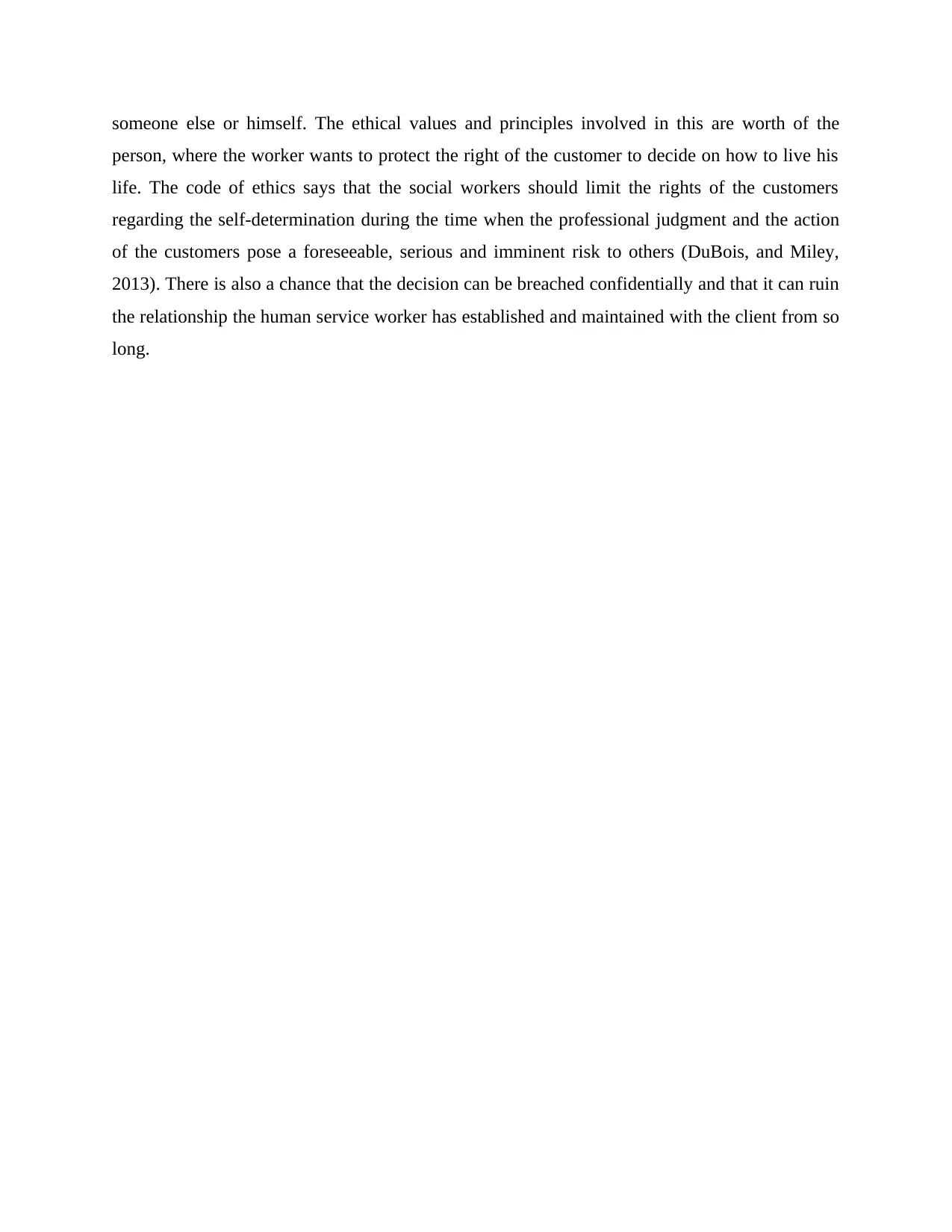
someone else or himself. The ethical values and principles involved in this are worth of the
person, where the worker wants to protect the right of the customer to decide on how to live his
life. The code of ethics says that the social workers should limit the rights of the customers
regarding the self-determination during the time when the professional judgment and the action
of the customers pose a foreseeable, serious and imminent risk to others (DuBois, and Miley,
2013). There is also a chance that the decision can be breached confidentially and that it can ruin
the relationship the human service worker has established and maintained with the client from so
long.
person, where the worker wants to protect the right of the customer to decide on how to live his
life. The code of ethics says that the social workers should limit the rights of the customers
regarding the self-determination during the time when the professional judgment and the action
of the customers pose a foreseeable, serious and imminent risk to others (DuBois, and Miley,
2013). There is also a chance that the decision can be breached confidentially and that it can ruin
the relationship the human service worker has established and maintained with the client from so
long.
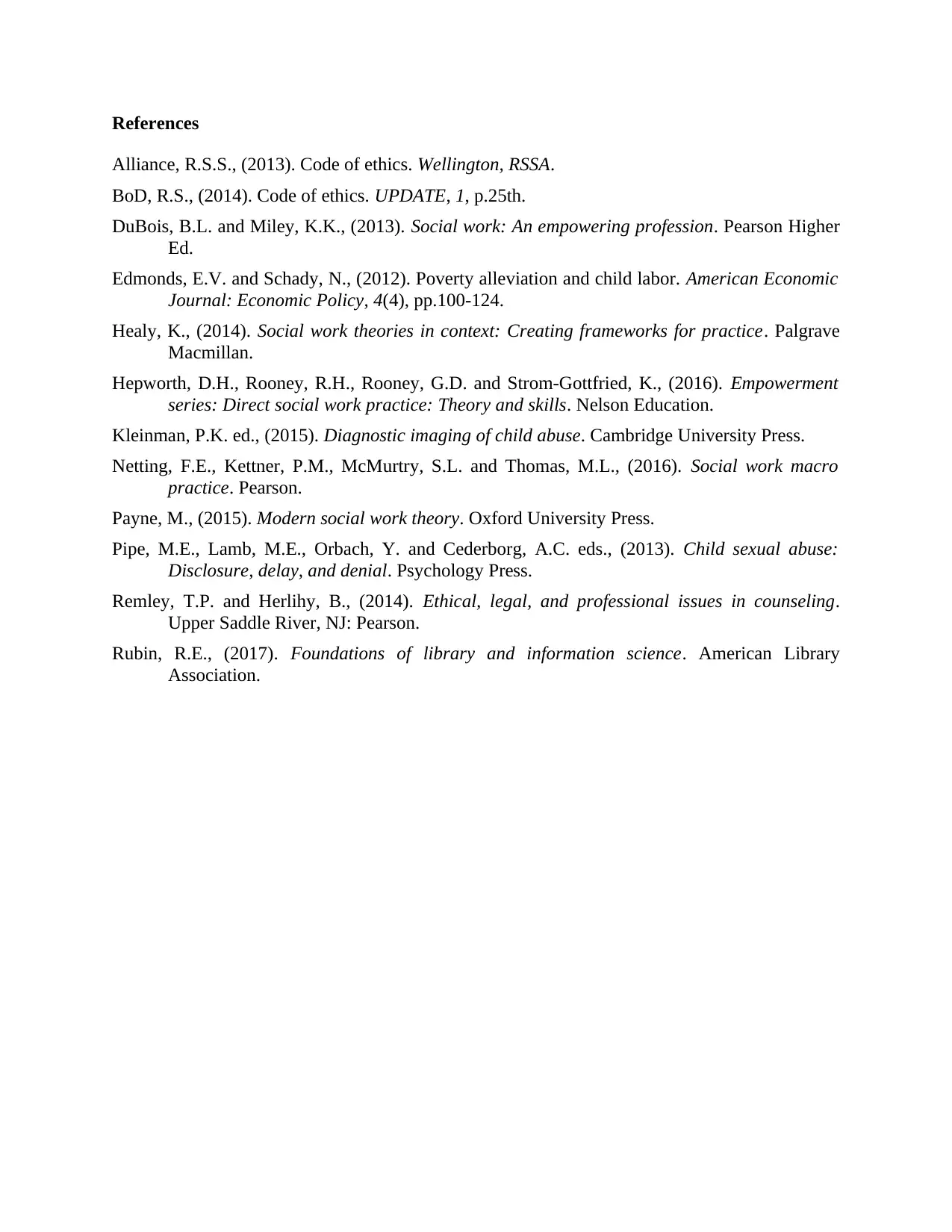
References
Alliance, R.S.S., (2013). Code of ethics. Wellington, RSSA.
BoD, R.S., (2014). Code of ethics. UPDATE, 1, p.25th.
DuBois, B.L. and Miley, K.K., (2013). Social work: An empowering profession. Pearson Higher
Ed.
Edmonds, E.V. and Schady, N., (2012). Poverty alleviation and child labor. American Economic
Journal: Economic Policy, 4(4), pp.100-124.
Healy, K., (2014). Social work theories in context: Creating frameworks for practice. Palgrave
Macmillan.
Hepworth, D.H., Rooney, R.H., Rooney, G.D. and Strom-Gottfried, K., (2016). Empowerment
series: Direct social work practice: Theory and skills. Nelson Education.
Kleinman, P.K. ed., (2015). Diagnostic imaging of child abuse. Cambridge University Press.
Netting, F.E., Kettner, P.M., McMurtry, S.L. and Thomas, M.L., (2016). Social work macro
practice. Pearson.
Payne, M., (2015). Modern social work theory. Oxford University Press.
Pipe, M.E., Lamb, M.E., Orbach, Y. and Cederborg, A.C. eds., (2013). Child sexual abuse:
Disclosure, delay, and denial. Psychology Press.
Remley, T.P. and Herlihy, B., (2014). Ethical, legal, and professional issues in counseling.
Upper Saddle River, NJ: Pearson.
Rubin, R.E., (2017). Foundations of library and information science. American Library
Association.
Alliance, R.S.S., (2013). Code of ethics. Wellington, RSSA.
BoD, R.S., (2014). Code of ethics. UPDATE, 1, p.25th.
DuBois, B.L. and Miley, K.K., (2013). Social work: An empowering profession. Pearson Higher
Ed.
Edmonds, E.V. and Schady, N., (2012). Poverty alleviation and child labor. American Economic
Journal: Economic Policy, 4(4), pp.100-124.
Healy, K., (2014). Social work theories in context: Creating frameworks for practice. Palgrave
Macmillan.
Hepworth, D.H., Rooney, R.H., Rooney, G.D. and Strom-Gottfried, K., (2016). Empowerment
series: Direct social work practice: Theory and skills. Nelson Education.
Kleinman, P.K. ed., (2015). Diagnostic imaging of child abuse. Cambridge University Press.
Netting, F.E., Kettner, P.M., McMurtry, S.L. and Thomas, M.L., (2016). Social work macro
practice. Pearson.
Payne, M., (2015). Modern social work theory. Oxford University Press.
Pipe, M.E., Lamb, M.E., Orbach, Y. and Cederborg, A.C. eds., (2013). Child sexual abuse:
Disclosure, delay, and denial. Psychology Press.
Remley, T.P. and Herlihy, B., (2014). Ethical, legal, and professional issues in counseling.
Upper Saddle River, NJ: Pearson.
Rubin, R.E., (2017). Foundations of library and information science. American Library
Association.
⊘ This is a preview!⊘
Do you want full access?
Subscribe today to unlock all pages.

Trusted by 1+ million students worldwide
1 out of 6
Related Documents
Your All-in-One AI-Powered Toolkit for Academic Success.
+13062052269
info@desklib.com
Available 24*7 on WhatsApp / Email
![[object Object]](/_next/static/media/star-bottom.7253800d.svg)
Unlock your academic potential
Copyright © 2020–2025 A2Z Services. All Rights Reserved. Developed and managed by ZUCOL.





